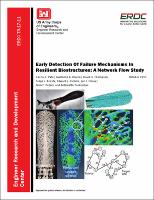Please use this identifier to cite or link to this item:
https://hdl.handle.net/11681/24960| Title: | Early detection of failure mechanisms in resilient biostructures : a network flow study |
| Authors: | Patel, Reena R. Riveros, Guillermo A. Thompson, David S. Acosta, Felipe J. Perkins, Edward J. Hoover, Jan Jeffrey 1954- Peters, John F. Tordesillas, Antoinette |
| Keywords: | Biomechanics Structural analysis (Engineering) Kinematics Stress concentration Morphology Materials--Elastic properties |
| Publisher: | Information Technology Laboratory (U.S.) Environmental Laboratory (U.S.) Engineer Research and Development Center (U.S.) |
| Series/Report no.: | ERDC;TR-17-11 |
| Abstract: | The area of bioinspired material design is fairly young and mainly unexploited. This research aims to gain fundamental understanding of the hierarchical lattice architecture in the paddlefish rostrum and use this knowledge to obtain new insights for a wide range of applications. This work presents an integrated, interdisciplinary approach that employs computational mechanics and the theory of network statistics to gain fundamental insights into the failure mechanisms of high performance, lightweight, structured composites by examining the geometry and material properties of the rostrum. Results from computational mechanics simulations and network flow analysis are presented with emphasis on the load transfer mechanism in the Bio-Structure. The structure is formed from a network of structural elements that carries forces through combinations, or chains, of structural members called force chains in reference to similar structures generally observed in granular media. These force chains are often aligned in the principal direction of the external stress to which the system is subjected. The current research presents a flow network analysis of the rostrum with and without the presence of the lattice architecture. Highly localized force chains were formed in the rostrum with similar loading conditions in absence of the lattice architecture. The flow network was also able to capture the stain localization in the tensile region of the rostrum and the asymmetrical response of the rostrum to uniform loading. |
| URI: | http://hdl.handle.net/11681/24960 http://dx.doi.org/10.21079/11681/24960 |
| Appears in Collections: | Technical Report |
Files in This Item:
| File | Description | Size | Format | |
|---|---|---|---|---|
| ERDC TR-17-11.pdf | 5.42 MB | Adobe PDF |  View/Open |